During the past week, I engaged in a binge-visit marathon and attended five of the new pop-up environments located in New York. My aim was to experience the role that technology has in this quickly expanding market catering to the Instagram-hungry public always eager to capture themselves in noteworthy, quirky, or hyped environments. While the technology was certainly present, front and center, the most significant element of these endeavors is the real estate factor.
Let me explain. In New York, similar to most urban centers large and small, there is a lot of commercial real estate that sits empty and unrented due to a number of factors. The continued elimination of brick and mortar retail as well as high rents that have forced out many “mom & pop” shops (if that seems like a contradiction, I agree), leave many commercial landlords with unoccupied space. I suppose they are waiting for the next Starbucks to sign a lease and move in.
In New York, you can see this in tony neighborhoods like the Upper East Side as well as grittier locations Downtown. However, we shouldn’t despair, as into this void has jumped the new-age entrepreneur with fantastic concepts for short term leases that generate cash flow for the landlord and the renter. As a result, we have spaces given over to experiential installations that run from the plebeian to the very sophisticated covering topics from ice cream to rosé to consciousness-raising.
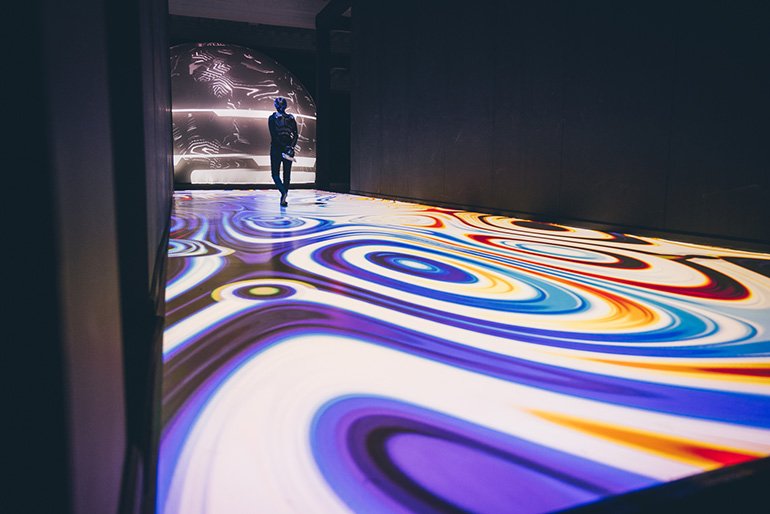
Projection Mapping and Trans-Dimensional Beings
My first stop was an installation called “Zerospace," which is located within a ground floor space near Penn Station. Billed as an “immersive art experience” with an “immersive theater” element, this production was heavy on narrative related to a journey to an “inter-dimensional portal,” where humans meet beings from some other dimension. In reality, the narrative is a superficial vehicle that strings together a series of multimedia installation rooms while providing an excuse to place a dozen drama students in masks and costumes who appear to be having a very good time.
My immersive theater interaction consisted of a one-on-one conversation with one of the trans-dimensional beings – I think she (or it) was from the dimension of Sophomore, adjacent to the NYU Helix – and we talked about why humans equate beauty with perfection and symmetry. This interrogation was followed by an inter-dimensional dance performance that lacked perfection or symmetry but had low-key charm.
For media, we had a projection dome, some façade and floor mapping, an interactive sandbox gag, and most interestingly, a very custom LED pixel ceiling that was really quite beautiful and engaging. The ceiling consisted of a loose layer of what appeared to be Spanish moss hanging down in the form of tendrils. Above that were a few small strobes. The moss was actually LED pixels suspended in thin wire, and it was a fairly massive array animated in an engaging and dynamic fashion. Think rolling clouds back-lit by bolts of lightning. It would’ve been easy to lie there and watch it for quite a while, but I had a schedule to keep.
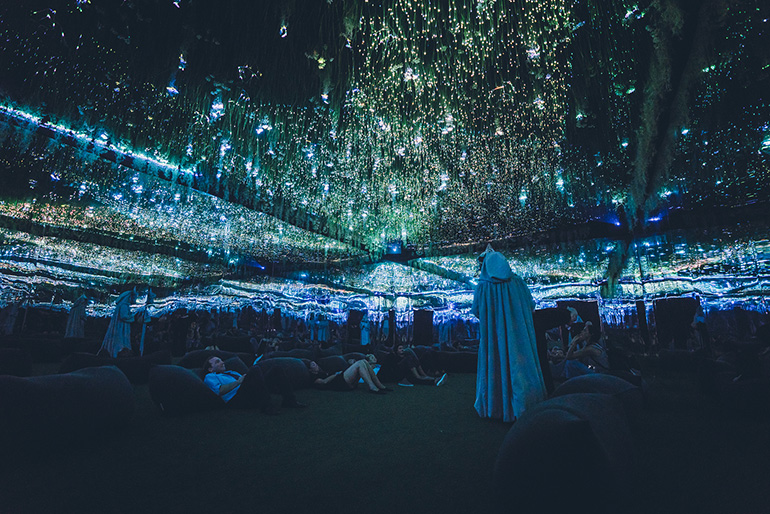
SuperReal
Housed in the very grand, ornate, and landmarked first-floor interior of the 1921 Cunard Building near Wall Street, this installation is the result of the partnership between entertainment studio Moment Factory and Cipriani, the hospitality and event company that leases the space. With the event business in New York mired in typical summer doldrums, creating a tourist magnet via immersive spectacle must have been very appealing as a filler.
Fundamentally, SuperReal is projection mapping on a very large scale. The installation plays out a series of visual dreamscapes and, from a technical perspective, it is a tour de force. Cramming the projection, sound, and lighting gear required to create a 360° experience in a space this large, where all the interior architecture cannot be disturbed, is a very impressive technical feat. Kudos for good image quality, audio impact, and smooth integration of lighting effects.
In terms of content, there is a little bit of everything from particle flow to architectural enhancement. I found most of it only ok. It could’ve used a bit of a human element rather than just the abstract patterns, figurative building and garden motifs and stained-glass themes that make up the “dreams.” However, just when I was thinking about heading out, a dream sequence played that was brilliant in its pacing, drama, and visual/auditory impact (I think it was DREAM III). This piece alone made Superreal worth visiting. The big white balloons were purely a bonus.
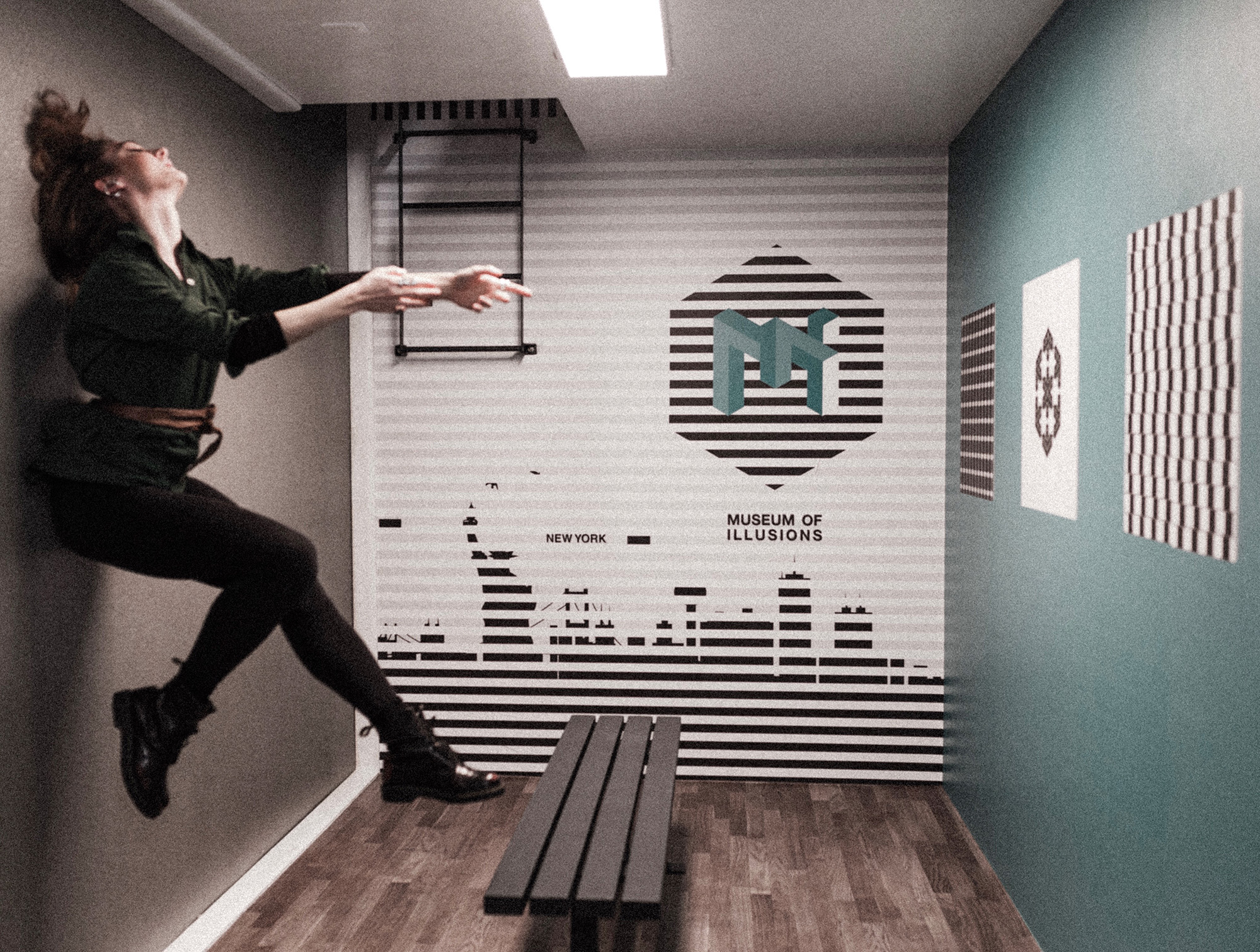
Mirrors without Smoke at the Museum of Illusions
An exhibit that traveled the world before landing in New York last year, MOI, is a catalog of every visual illusion familiar to theater professionals, who have been using perspective tricks of the type shown here for millennia. That does not take away from their effectiveness or the delight evident throughout the visitors. In general, the graphics, mirrors, and objects that make up the different exhibits are well maintained and thoughtfully designed.
In terms of technology…well, except a few holographic images (real holographs!) there wasn’t any technology utilization here. However, the MOI experience is still worth considering for one significant reason – the visitor demographic. While the other installations I visited were clearly intended for the tourist or “Sleep No More” crowd, the MOI appears to be extremely popular amongst the young, urban population, and boy, did they get a kick out of this. Experiencing their engagement and excitement made a fun visit for this jaded journalist.
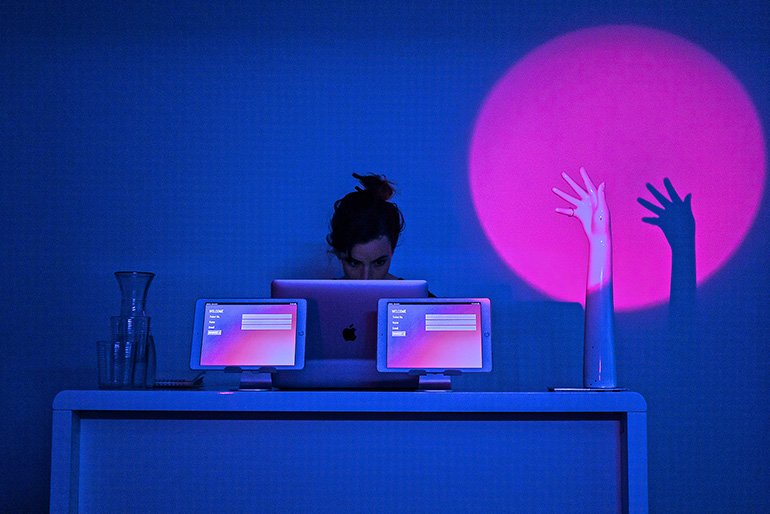
Museum of Future Experiences
Located in the Soho loft building that once housed Andy Warhol’s Factory, MoFE is very different from the other pay-for-experience pop-ups due to its extremely personal nature. The intimacy begins with an in-depth introduction given by a white-lab-coat-adorned attendant who addresses the visitor group. In my case, it was a total of six people – two couples and two singles, all unknown to each other.
The attendant asks each of the participants the same series of questions related to sleep patterns, dream states, and fear triggers. These answers, as well as an additional set of questions answered privately on iPads, determines which specific VR content you will experience in the first of two VR sessions. The second VR session provides the same content for all participants, and this is followed by a sit-down group talk where you can compare and discuss the experience with your fellow visitors.
The designers of this experiment are attempting to use Virtual Reality as a conduit to an epigrammatic personal journey, and they support this with a very attentive, almost spa-like environment. It makes quite a contrast to the VR arcade most of us have experienced. Overall, it’s an interesting and memorable experience, although based on the VR narrative I consumed, my Future Experience appears to be somewhat challenged by death and destruction. After an hour, the experience ended, and with a newly cautious view of my future, I headed out into the humid New York summer and looked for the nearest bar.
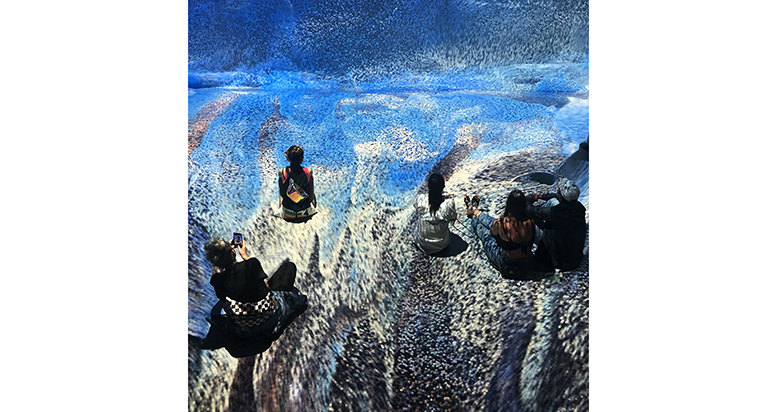
ARTECHOUSE
ARTECHOUSE recently opened their New York location - described as “the home in [those cities] for an innovative, 21st-century art that is created at the intersection of art, science, and technology.” Powered by more than a dozen Barco 4K projectors, the New York installation is housed in the unused boiler room at the sprawling Chelsea Market building.
Differing from other similar set ups like Superreal, ARTECHOUSE aims to provide a continuously operated space that is home to installations that will change every few months. The inaugural piece is Machine Hallucinations by Refik Anadol, the Los Angeles-based digital artist, and it is billed as a “synesthetic reality experiment.” Using machine algorithms to sort through and pattern a library of 100-million images of New York, the content runs through a sequence of different looks that cover the walls and floor of the space, providing an immersive background for Instagram shots.
Image and sound quality is top-notch, and I give well-earned props to the techs that handled the projector alignment. However, like the other “experiences” I experienced over the past two weeks, much of the content did not measure up to the technical aspects. For me, Machine Hallucinations seemed repetitive, unconnected with the New York that it is supposedly based on and sorely lacking in any kind of human narrative. Machines and programming creating artwork to be viewed by machines and programming, it could be said.
Also, keep in mind that the ARTECHOUSE single-price admission would pay for an entire day spent at the Metropolitan, Whitney, or any of the other great New York art museums. My hope is that in the future, these installations will move past the pretty background images mode and use these innovative environments to stage work that viewers will appreciate for their human connection, not just their smartphone camera connection.
Fad or Future Permanent?
As real estate developers continue to build projects that incorporate space for retail tenants that no longer exist, it’s safe to assume that people like those described above and other organizations like wallplay will continue to come up with ideas to bring people into these spaces and in many cases, charge money to do so. Is this a bad or inconsequential thing? I don’t think so.
Whether the experiences encompass art, theater, sci-fi, music, food, or some other aspect of our existence, they can provide more than just a place to get a cool selfie. They also provide an expansive canvas for ideas, creativity, and technology applications that might not exist otherwise, and that, I believe, is reason enough to support their existence.
Throughout a 40-year career in the entertainment technology business, Josh Weisberg has experienced each of the evolutionary leaps in sound, video, and lighting technology from a seat in the front row. Combining a rare level of business management and technical engineering acumen, Weisberg has a keen understanding of the mechanics of running a technology business as well as the engineering and design chops clients rely on for all types of projects. Currently working as a technology and business consultant (having stepped down from the leadership role at Scharff Weisberg and WorldStage in 2017), Weisberg utilizes his expertise in large-screen display design as well as other event technologies for clients in the event, arts, theater, and spectacle sectors.